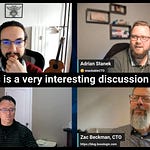Linear note taking is one of the least effective ways for our brains to interpret and connect with information. Our brains like to establish patterns, connections, mental maps. It’s impossible to build that when facing a huge wall of text.
But this is, by and large, how we were taught to learn.
What we aren’t taught is how to build mental maps, reframe new information, reason about it. We aren’t given the tools to find gaps in the knowledge. All because a huge wall of text is very hard for our brain to convert into a network of information. There is no network. It’s just a drawn out, tedious inventory of facts. Plus, all that writing is slow. This is why we call it “lower order learning.”
There is a much better way to capture, absorb, and master information.
Join me in this short video to discover a better way to learn, a way that:
Doesn’t distract us.
Is easy, quick, relevant.
Let’s us reason about new information.
Allows us to reframe that information into our own mental model.
Gives us more cues and strong connections to information.
Read the whole article: If you’re interested in the long-form post here’s the link. The article includes callouts, references, a “tips” section, and goes a bit deeper. →
Transform the way you learn with spatial thinking & a second brain
You can master anything quickly, but you have to stop studying and start reframing. Here’s the secret.



